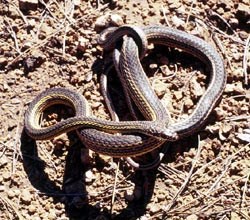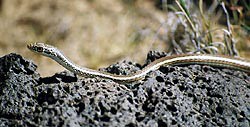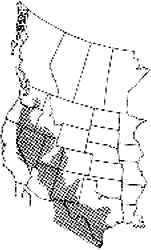Masticophis taeniatusSize (length): 30-72 inches (76-183 cm) Habitat: Forest, Savanna, Shrubland, Grassland, Desert Diet: lizards, small mammals, snakes, young birds, insects Predators: Birds of prey, other snakes 
NPS General Biology: Striped Whipsnakes are long, striped, non-venomous snakes. They can range in length from 30 to 72 inches. Their upper side is black or brown with white stripes along their length, and they have a white or cream-colored underside. Because of their length, speed, and coloring, they are often described as looking like a leather whip, giving them their name. They can live for up to 20 years. 
NPS Behavior: Striped Whipsnakes are found in the Western United States and Northern Mexico. Their typical habitats are grasslands, forests, or rocky canyons Within these habitats, they are often found in rocky areas or near streams.Striped Whipsnakes are active during the day. They rely on their acute vision to find prey, often elevating their head and moving it from side to side to get a better view. They are also good climbers and can escape predators by climbing into shrubs or trees. In the winter, Striped Whipsnakes are dormant and stay in communal dens often made from abandoned rodent burrows. Their breeding season starts when they emerge in the Spring. In the Summer, females lay eggs in groups of 3-12, which typically hatch in August or September. 
NPS Conservation: Striped Whipsnakes are not considered threatened or endangered. However, human activity does have an impact on these animals. The expansion of agriculture has decreased the area available for Striped Whipsnake habitat. All animals are protected in National Parks; therefore it is illegal to harass or harm them. Additionally, getting too close or attempting to catch wild animals is not safe. While they are not venomous, Striped Whipsnakes are aggressive and will bite if disturbed or captured. 
NPS When to see at Bryce Canyon: Because Striped Whipsnakes are one of the few species of desert snakes that are diurnal, they are most likely to be spotted during the day. In Utah they are typically active from late March to October, as they enter a state of dormancy called brumation in the Winter.
|
Last updated: September 2, 2024
